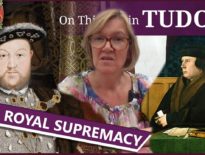On the afternoon of this day in Tudor history, Wednesday 4th June 1561, in the reign of Queen Elizabeth I, London was hit by a tremendous thunderstorm. Fires caused by lightning strikes destroyed one church and damaged St Paul's Cathedral.
Find out more about the storm, how St Paul's was damaged, the reactions to the lightning strike, what Queen Elizabeth I did, and what happened next, in today's talk.
Also on this day in Tudor history, 4th June 1550, sweethearts Robert Dudley and Amy Robsart tied the knot at the royal palace of Sheen at Richmond in a service attended by King Edward VI. This marriage was a love-match, but it lasted just ten years, ending with Amy's death in 1560, a death which is surrounded by controversy. Find out more in last year’s video:
Also on this day in history:
- 1534 – Death of Sir Edward Guildford at Leeds Castle. Guildford acted as guardian to John Dudley (future Duke of Northumberland) and held the posts of Marshal of Calais, Constable of Dover Castle and Lord Warden of the Cinque Ports.
- 1573 – Death of Sir Francis Jobson, administrator, at Monkwick, near Colchester. He was buried in St Giles, Colchester. Jobson was a member of Henry VIII's household, was Master of the Jewel House in 1553, escaped trial for supporting John Dudley in July 1553 and was pardoned by Mary I, and served Elizabeth I as Lieutenant of the Tower of London.
- 1590 – Baptism of William Cecil, 16th Baron Ros, courtier, ambassador. He was baptised at Newark Castle and was the son of the eldest son of William Cecil, 2nd Earl of Exeter, and Lady Elizabeth Manners.
- 1597 – Death of Sir Thomas Baskerville, soldier, at Picquency, in Picardy. He had served in the Netherlands under Robert Dudley, Earl of Leicester, and Peregrine Bertie, Baron Willoughby de Eresby, and was knighted in 1588 after the capture of Bergen op Zoom. He was buried in St Paul's Cathedral.
- 1603 – Death of Christopher Goodman, Church of England clergyman and radical Protestant, at Chester.
- 1626 – Burial of Thomas Howard, 1st Earl of Suffolk, naval officer and administrator, at Charing Cross, London. He was buried in the Howard vault of Saffron Walden church. He captained the Golden Lion in the struggle against the Spanish Armada in 1588.
Transcript:
On the afternoon of this day in Tudor history, Wednesday 4th June 1561, the eve of Corpus Christi, the city of London was hit by a tremendous thunderstorm. According to contemporary accounts, there was “a marvellous great fiery lightning” and “a most terrible hideous crack of thunder, such as seldom hath been heard.”
Contemporary accounts recorded that “a thunderbolt smote down certain great stones from the battlement of the steeple” of the Church of St Martin Ludgate, “which fell down upon the leads of the church, and brake the leads and boards, and a great chest in two pieces. The church was completely destroyed by fire.
Lightning also struck the steeple of St Paul’s Cathedral. Stephen Porter, in “Everyday Life in Tudor London”, explains that this steeple was made from oak covered with lead, and that it was topped with a ball containing relics, a cross and a weatherc*ck, which was in the form of an eagle. The steeple dated back to 1462, when it replaced a steeple that had been hit by lightning on Candlemas Eve in 1444. In 1506, the weatherc*ck had been replaced after the wind had blown it down, and in 1553, the whole steeple had been removed and repaired.
In “A Survey of the Cities of London and Westminster, Borough of Southwark, and Parts Adjacent” which was based on the work of 16th century historian John Stow, is the following account:
“In the year 1561, the 4th of June, betwixt the hours of three and four o’clock in the afternoon, the great spire of the steeple of St. Paul’s Church was fired by Lightning. Which broke forth (as it seemed) two or three Yards beneath the Foot of the Cross; and from thence it burnt downwards from the Spire, to the Battlements, Stone-Work, and Bells, so furiously, that within the Space of four Hours the same Steeple, with the Roof of the Church, were consumed.”
Contemporary accounts don’t agree on what time the lightning struck the steeple, but the fire was recorded as breaking out around four o’clock in the afternoon, starting just below the ball. Holes had been left in the lead for scaffolding and so the fire caught the oak underneath and within around 15 minutes the cross and eagle fell onto the roof of the south transept, and the steeple, was described as burning “downward, like a candle consuming”. The melted lead of the steeple poured down on the roof like molten lava and the cathedral bells melted. All the roofs of the cathedral caught fire and the rafters were consumed. The streets below “seemed to be paved with lead”. The air was full of sparks and debris.
As the steeple burned, a crowd gathered, and there was talk of shooting the steeple down with artillery or men scaling the roof to attack it with axes to try and stop the fire spreading, but things happened so fast that it was decided instead to concentrate on saving the bishop’s palace with joined onto the cathedral on the north side. If the palace had caught fire then the fire would also have spread to its adjoining properties. 500 people were involved in fetching water, and they did manage to save the palace, but the steeple and all four of the cathedral roofs were completely destroyed. The interior of the cathedral survived except for the communion table.
It was soon rumoured that the fire had been started by a negligent plumber who had left a pan of hot coals in the steeple, but no plumber or workman had laboured in the cathedral for 6 months, and there were also rumours that it was caused by “some wicked practice of wild fire or gunpowder”, but there was no evidence to support this. Others blamed the fire on popery while others blamed the Puritans. James Pilkington, Bishop of Durham, preached at Paul’s Cross that it was “a general warning for the whole realm and namely to the city of London of some greater plague to follow, if amendment of life in all states did not follow”. It was seen as a sign from God.
It was recorded that Elizabeth I sent her mandate to the Lord Mayor of London commanding him “to take a method for the immediate repair of the damage”. William Benham, in his 1902 book “Old St Paul’s Cathedral”, explains that the queen gave the mayor 1000 marks from her own purse and provided him with warrants for 1000 loads of timber from her woods. The clergy and layment of London were able to raise nearly £7,000, and within a month there was a temporary roof of boards and lead. By the end of the year, the aisles of the church were recorded as being “framed out of new timber, covered with lead, and fully furnished”, and the cathedral had been completely reroofed by April 1566. However, the steeple was never rebuilt.
100 years after the cathedral had been reroofed, the whole of St Paul’s Cathedral was destroyed in the September 1666 Great Fire of London. The present building was built between 1675 and 1710 and was designed by Sir Christopher Wren.



Excellent as ever.